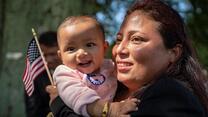The next U.S. administration will take office during a critical time in the COVID-19 response overseas. In fragile countries, the pandemic is driving a “double emergency” in which vulnerable populations are experiencing not only the direct health impacts of the virus, but also its secondary devastation to weak humanitarian, economic, security and political environments. In these crisis-affected contexts, state structures are often unable or unwilling to provide essential services and the most vulnerable – refugees and displaced persons in particular – are often left out of national response plans and services either by accident or by design. Populations in these settings thus rely on humanitarian NGOs and a robust multilateral response to fill critical gaps during COVID-19 outbreaks.
Despite the scale and severity of the virus, related lockdowns, and secondary effects in fragile settings, the Trump Administration has failed to mount an adequate response. U.S. funding levels remained low, funding flows were dangerously slow, and very little made its way to partners on the frontlines who were best positioned to respond. At the same time, the global nature of the crisis, together with existing and newly created bureaucratic and political obstacles, blunted USAID’s traditional strengths and constrained implementing partners. Humanitarians found themselves responding to a vast array of local contexts, many of which restricted humanitarian action. As virus epicenters shifted and secondary impacts became more acute, there was little flexibility in the response to allow humanitarians to track risk, deploy resources where needed, and adapt innovations at scale. The result was an underfunded and rigid response that failed to address the unique challenges of a global pandemic that both catalyzed global disruptions and demanded rapid, bespoke interventions at the community-level.
U.S. failings had a global impact. Without U.S. leadership, multilateralism faltered. Global supply chains were chaotic, constraints on humanitarian access went unaddressed, the UN’s Global Humanitarian Response Plan (GHRP) for COVID-19 remained underfunded, and efforts to offer social protections for the world’s most vulnerable failed to launch. The most vulnerable may pay the price today but controlling the outbreak and mitigating its secondary impacts in fragile settings is a necessary prerequisite to ending the pandemic globally. Otherwise, the pandemic and its wider impacts risk spreading unchecked and reversing decades of U.S. investments abroad and hard-won progress to reduce poverty, inequality, hunger, violence, and disease.
The Biden campaign’s plans to restore U.S. leadership and mobilise a coordinated international response to assist vulnerable nations are welcome and critical steps to alter the trajectory of the pandemic and its aftereffects and reassert U.S. global leadership writ large. To jumpstart these efforts, the Biden administration should:
- Provide greater funding and ensure it reaches frontline responders in fragile settings.
- Re-establish USAID’s traditional speed and agility by removing bureaucratic and policy constraints and ensuring flexibility and innovation, particularly in USAID’s Bureau for Humanitarian Assistance.
- Galvanise multilateral coordination aimed at securing more international financing and use it to incentivise more inclusive policies, secure exceptions to protect and expand humanitarian access, and lay the groundwork for a long-term response to the pandemic’s devastating secondary impacts.



